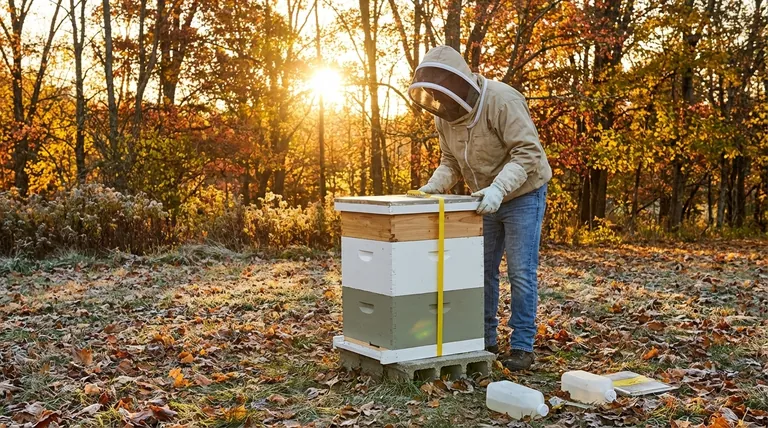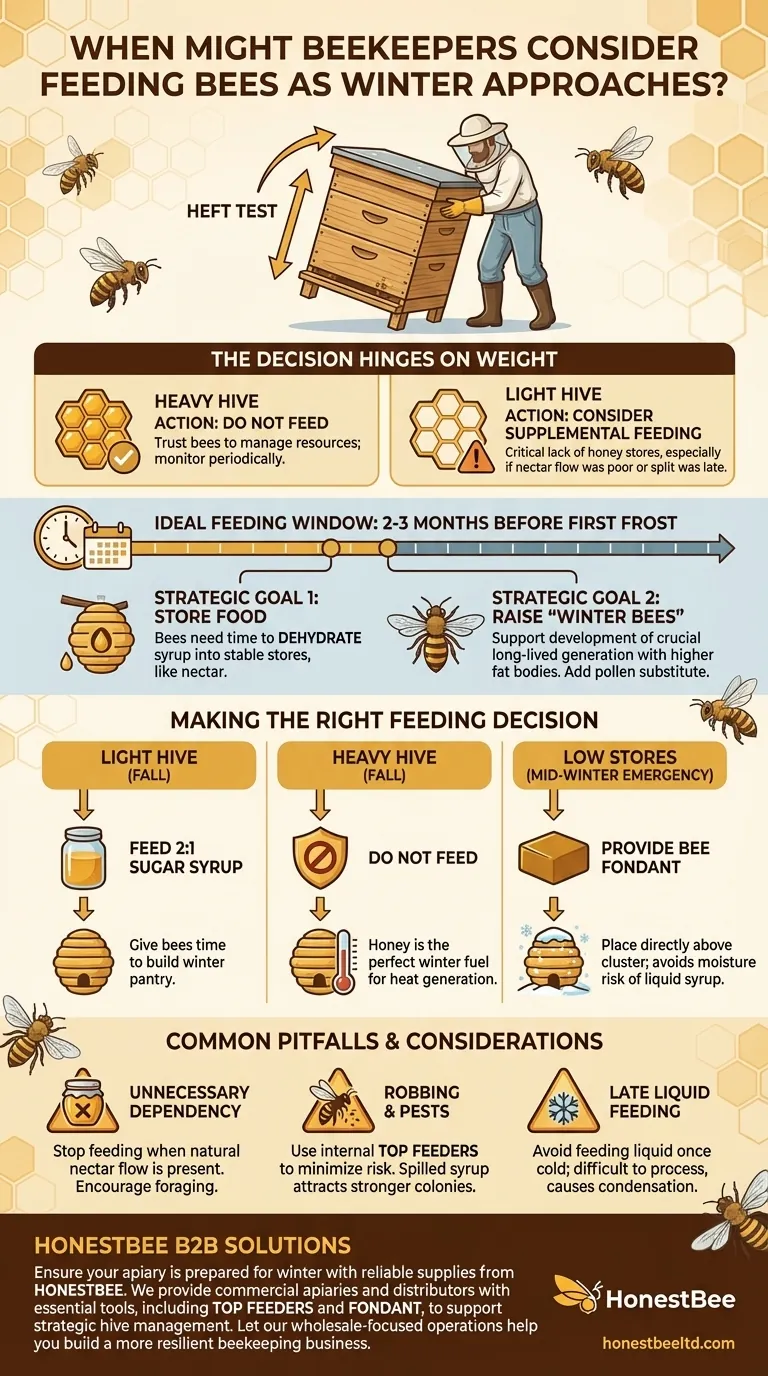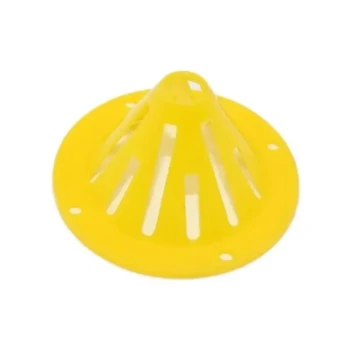The decision to feed bees before winter hinges on one critical factor: the weight of their stored honey. You should consider feeding your colony if it has not built up sufficient honey reserves due to factors like a poor nectar flow or a late-season split. The ideal window to begin this supplemental feeding is approximately two to three months before the first expected frost in your area.
Your goal is not merely to give bees sugar, but to strategically correct a resource deficit. Proper fall feeding ensures the colony has enough time and energy to raise its crucial generation of long-lived "winter bees" and properly store the food it needs to survive the cold months ahead.

Assessing Your Hive's Winter Readiness
Before you mix a single drop of sugar syrup, you must determine if your bees actually need your help. Intervening unnecessarily can do more harm than good.
The Critical Role of Honey Stores
Honey is the perfect winter food for bees. It is their carbohydrate fuel source, allowing the winter cluster to vibrate their wing muscles and generate the heat necessary to survive freezing temperatures. A lack of honey means a lack of fuel, which is a fatal problem in the cold.
How to Check Your Hive's Weight
The most reliable way to gauge food stores without a full inspection is the heft test. Tip the hive from the back; a colony with adequate stores will feel very heavy, almost as if it's "glued to the ground." A light hive indicates a critical lack of honey and is a clear sign that you need to intervene.
Why Natural Stores Are Superior
While sugar syrup is an effective supplement, it's important to remember that it is not a perfect replacement for honey. Honey contains enzymes and micronutrients that sugar syrup lacks. Feeding should always be viewed as a corrective measure, not a routine practice.
The Strategic Timing of Pre-Winter Feeding
When you feed is just as important as what you feed. The calendar is your most important tool in this process.
The "2-3 Month" Window
Starting to feed two to three months before the first frost is crucial. This gives the bees ample time to take down the syrup, dehydrate it to the proper moisture content, and store it in the comb just as they would with nectar.
Raising "Winter Bees"
This time window also coincides with when the queen is laying the eggs that will become the final generation of bees for the season. These "winter bees" have higher fat bodies and are physiologically built to live for months, not weeks. Providing a pollen substitute alongside sugar syrup during this period supports the development of this vital population.
The Problem with Late Feeding
Feeding liquid syrup once the weather turns cold is a mistake. The bees will have difficulty processing it, and the excess moisture introduced into the hive can lead to condensation and chill the cluster.
Common Pitfalls and Considerations
Feeding is a powerful tool, but it comes with risks that require careful management.
Creating Unnecessary Dependency
Bees should forage for themselves whenever possible. If you feed when there is a natural nectar flow, they may ignore natural sources and become reliant on the feeder. Once the colony is established and foraging actively, it's time to stop feeding.
Attracting Robbers and Pests
Spilled syrup or open feeders can trigger a "robbing" frenzy, where stronger colonies attack and steal the resources of a weaker one. This is often a death sentence for the hive being robbed. Always use an internal feeder, such as a top feeder, to minimize this risk.
Emergency Winter Feeding (Fondant)
Feeding liquid syrup in the fall is a proactive measure. If you discover mid-winter that a hive has unexpectedly consumed its stores, the solution is different. In this emergency scenario, you would provide a solid block of fondant directly above the cluster, offering a source of energy the bees can access without the moisture risk of syrup.
Making the Right Feeding Decision
Your actions should be dictated by a clear assessment of your colony's specific situation.
- If your hive feels light 2-3 months before the first frost: Begin feeding a 2:1 sugar syrup (two parts sugar to one part water) immediately to give them time to build up their winter pantry.
- If your hive feels heavy and has ample capped honey: Do not feed. Trust that the bees have managed their own resources and continue to monitor their weight periodically.
- If you are in mid-winter and a hive check reveals dangerously low stores: Provide a solid block of bee fondant directly over the cluster as an emergency energy source.
By accurately assessing your hive's needs and timing your support correctly, you transition from simply keeping bees to actively guiding their survival.
Summary Table:
| Key Factor | Action to Take | Timing |
|---|---|---|
| Hive feels light (heft test) | Begin feeding 2:1 sugar syrup | 2-3 months before first frost |
| Hive feels heavy with capped honey | Do not feed; monitor weight | Fall |
| Low stores discovered mid-winter | Provide emergency bee fondant | Winter (emergency only) |
Ensure your apiary is prepared for winter with reliable supplies from HONESTBEE. We provide commercial apiaries and beekeeping equipment distributors with the essential tools for success, including top feeders and fondant, to support strategic hive management. Let our wholesale-focused operations help you build a more resilient beekeeping business. Contact HONESTBEE today to discuss your supply needs.
Visual Guide

Related Products
- Professional Galvanized Hive Strap with Secure Locking Buckle for Beekeeping
- Yellow Plastic Bucket Pail Perch for Beekeeping
- Professional Spring-Action Queen Catcher Clip
- High Performance Cordless Electric Bee Shaker for Beekeeping
- Premium Traditional Copper Bee Smoker with Bellows
People Also Ask
- What maintenance is required for hive straps? A Guide to Cam Buckle vs. Ratchet Strap Care
- What are the types of Emlocks available? Choose the Right Strap for Hive Security
- What are the two styles of hive straps? Choose the Right Strap for Your Hive Security
- Why are hive straps important for beekeepers? Secure Your Hives Against Wind, Predators & Transport
- Can straps with hook ends be used for beehives? A Guide to Secure Hive Management



















